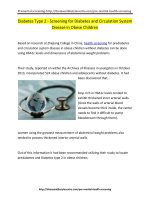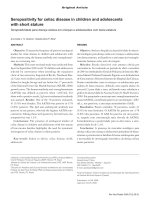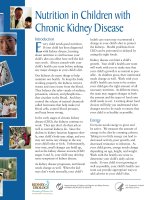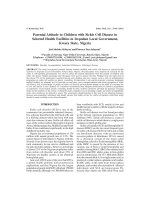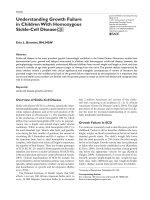Thyroid Disease in Children docx
Bạn đang xem bản rút gọn của tài liệu. Xem và tải ngay bản đầy đủ của tài liệu tại đây (665.51 KB, 40 trang )
Thyroid Disease in Children
Thyroid Disease in Children
Paul
Paul
Hruz
Hruz
MD PhD
MD PhD
Department of
Department of
Pediactrics
Pediactrics
September 2005
September 2005
Introduction
• Thyroid Disease is the Most Common
Endocrinopathy Observed in Children
• While the Disease Processes Present are
Similar to Those in Adults, the Incidences,
Presentations, and Clinical Consequences
Can Differ Markedly
• Failure to Diagnose and Treat Promply May
Lead to Irreversible Neurologic Damage
Lecture Outline
• Disorders of Thyroid Development
• Thyroid Disease in the Newborn
• Hypothyroidism in Children
• Hyperthyroidism in Children
• Thryoid Nodules
Thyroid Physiology of the
Fetus and Newborn
• Normal Thyroid Development
• Thyroid Status in Premature Infants
• Transplacental Passage of Thyroid Ab
• Newborn Screening
• Congenital Hypothyroidism
Thyroid Development
• Orignates from thyroid diverticulum
and ultimobranchial bodies
• Ontogeny influenced by several
transcription factors (TTF, PAX8,
HOX3)
• Largely complete by 10-12 weeks
• Gradual Maturation in Hypothalamic
-Pituitary-Thyroid Axis
Genetic Factors Impacting
Thyroid Development
Fetal Thyroid Maturation
• TSH detectable by 12 wks
• Feedback mechanisms
established by 20 wks
• T3 levels remain low
• Reverse T3 levels high
Placental and Fetal Thyroid
Metabolism
• Independent fetal axis
– Limited T
4
exchange
– Placental type 3 deiodoinase
• Effect of maternal
hypothyroidism
– Most important in first
trimester
• Permeable to TRH, IgG
and thionamides
Thyroid Changes at Birth
• TSH surge at birth
followed by T
4
and T
3
rise
• Important for
interpreting newborn
screen results
• Lower rise in preterm
infants
Cord Blood Thryoid Levels
• Influenced by
gestational age
• Progressive increase
with approach to
term
Thyroid Status in Premature
Infants
• Relative immaturity of axis
• Nadir at 2-3 wks
• Influences
– Illness,
– Iodine exposure,
– T4 clearance,
– Iodine stores
• TSH usually not elevated
Principles of Newborn
Screening
• Relatively High Prevalence
• Deleterious Consequence of
Delayed Diagnosis
• Difficult Clinical Recognition
• Reliable Method of Screening
(sensitive & specific)
• Safe, Effective Treatment
Available
Thyroid Effects in the Fetus
and Neonate
Congenital Hypothryoidism
• Incidence 1:4000
– Slightly higher in female infants
– Higher in Asian babies
– Lower in Black babies
• Primarily Sporadic Occurance
• Overt symptoms may not be present at birth
• Profound effects on brain development
• Reliable testing available (T4 and/or TSH)
• No sequelae if treatment initiated by 4 wks
– 10-15 mcg/kg/d
Etiology of Primary
Congenital Hypothryoidism
• Extensive testing for precise
etiology is generally not
necessary (will not change
immediate care plans)
• May allow assessment of risk
in future pregnancies
• May allow early
determination of transient vs
permanent disease
Transient Congenital
Hypothyroidism
• Defined as abnormal newborn screen with
abnormal confirmatory labs
– 75-80% of abnormal screens due to false +
• Incidence estimated to be ~10% of cases
• Most common in premature infants
•Causes:
– Iodine deficiency or excess
– Maternal antithyroid medication
– Maternal TSH receptor blocking antibodies
Maternal TSH receptor
blocking antibodies
• Incidence estimated at 1:180,000
• Often history of treated Graves in mom
– Mothers may have unrecognized hypothryoidism
• Infant will not have goiter
– Difficult to distinguish from thyroid dysgenesis
• May have permanent neurocognitive deficit if
present in utero
• Resolves in 2-3 months as antibody clears
Treatment Guidelines
• Confirm all abnormal newborn screens with
laboratory TSH and free T
4
– Borderline results may require repeat testing in 2-4
wks
• If repeat labs abnormal, begin thryoxine (25-37.5
mcg/day)
– Goal is to start treatment within first month of life
• Recheck q 2-3 months and adjust dose if
necessary
• If no need to increase dose by 2 ½ -3 yrs, give 4
wk trial off of thyroxine
Hypothyroidism
• Congenital
– Primary
• Thryoid Agenesis
• Dyshormonogenesis
• Iodine Deficiency
– Secondary
• Hypopituitarism
– Isolated
– Multiple hormone deficiency
•Acquired
– Primary
•Surgery
• Radiation
• Autoimmune
• Iodine Deficiency
– Secondary
•Surgery
• Radiation
• Infiltrative
• Tumor
Common Symptoms and Signs
of Hypothyroidism in Children
Growth Failure in Childhood
Hypothyroidism
Hypothyroidism: Treatment
Hashimotos Thyroiditis
• Most common cause of acquired hypothyroidism
• Female:Male (3:1)
• Most children present with asymptomatic goiter
• Clinical Symptoms may be nonspecific
• More frequent in Down and Turner Syndrome
Goiter: Differential Diagnosis
• Congenital
– Dyshormonogenesis
– Maternal Antibodies
• Blocking
•Stimulating
– Maternal Antithyroid drug
• PTU, methimazole
– TSH receptor Activating
Mutation
– McCune Albright Syndrome
–Thyroid Tumor
•Acquired
– Inflammation
– Colloid
– Iodine Deficiency
– Goiterogen
– Infiltrative disease
– Toxic goiter
– Thyroglossal duct
cyst
– Adenoma
–Carcinoma
Endemic Goiter
• Usually euthryoid
• Diffuse gland enlargement
• Rare in US (iodized salt provides adequate iodine
source)
• Rule out autoimmune thyroiditis
• Treament Doses in Children (6-12 months)
– Infants 100 mcg/d
– Children 200 mcg/day
– Adolescents 200-300 mcg/d
